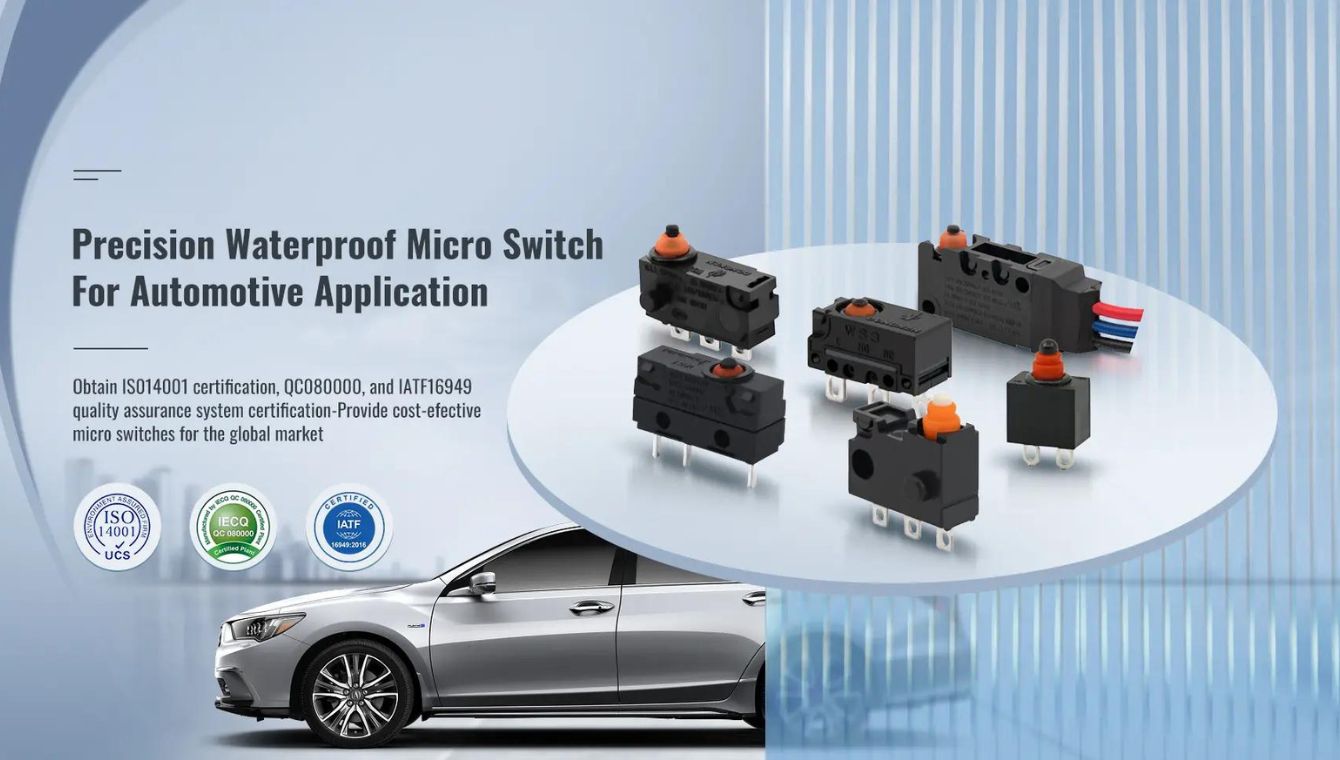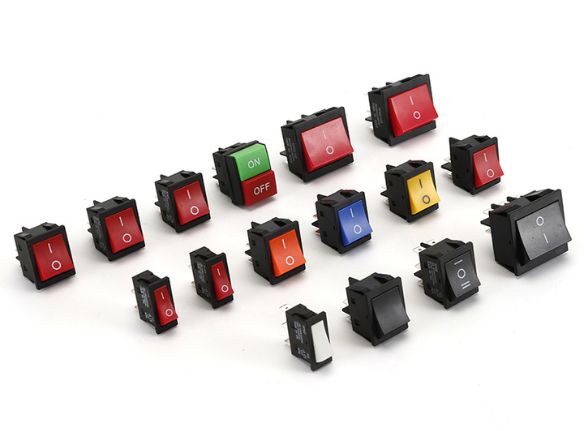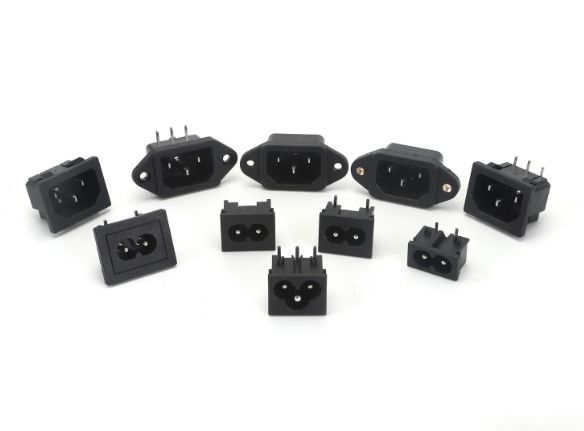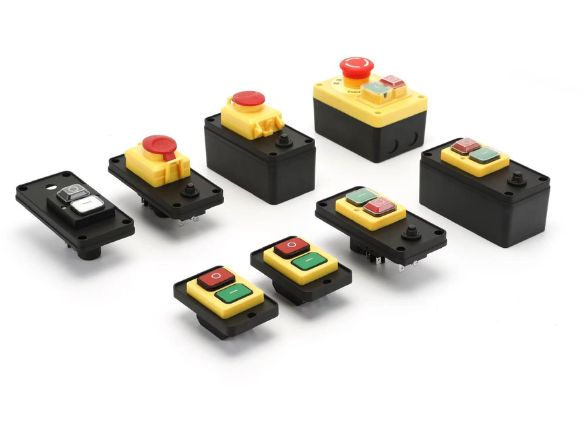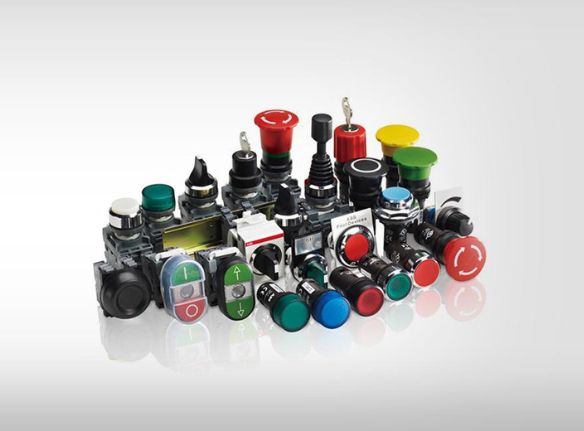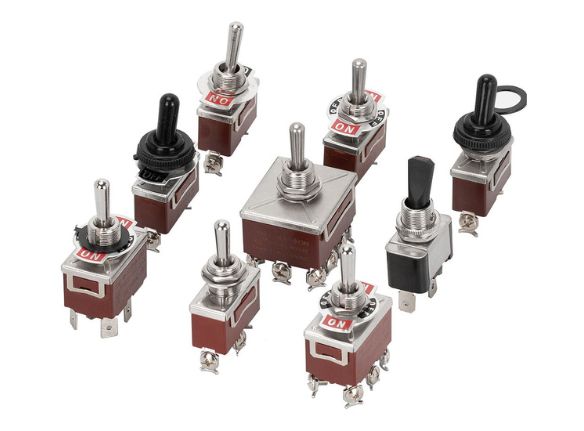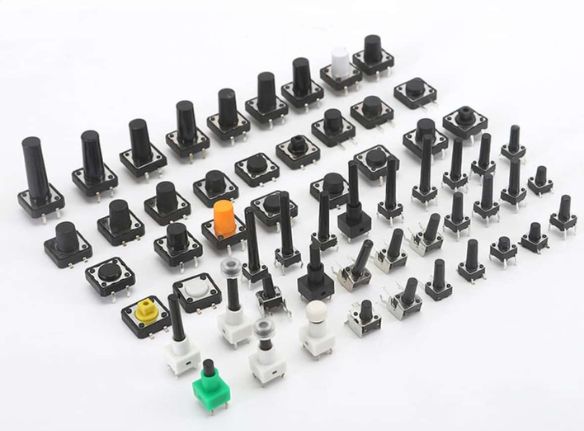With Full Product Certification

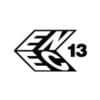






What are ON OFF Switches?
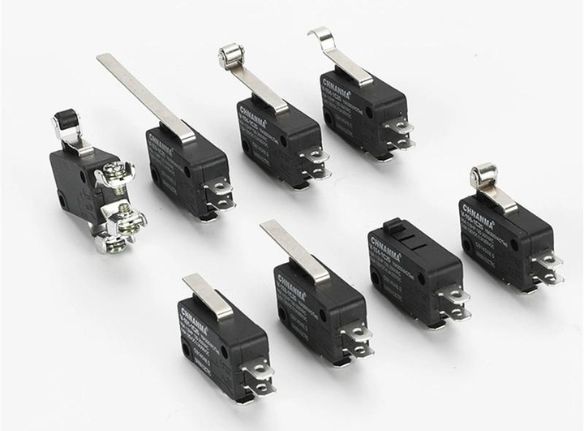
Working Principle
ON OFF switches operate in two primary modes
- Maintained Operation Mode: In this mode, the switch remains in its last position (either ON or OFF) until manually changed. Most toggle switches, rocker switches, and slide switches operate in this manner, staying in position without requiring continuous user interaction.
- Momentary Operation Mode: In this mode, the switch returns to its default position (usually OFF) once the user releases the actuator. Push button switches often use this operation mode, requiring the user to maintain pressure on the button to keep the circuit closed.
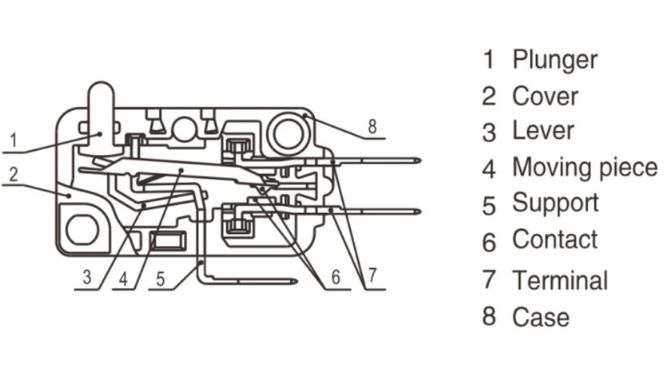
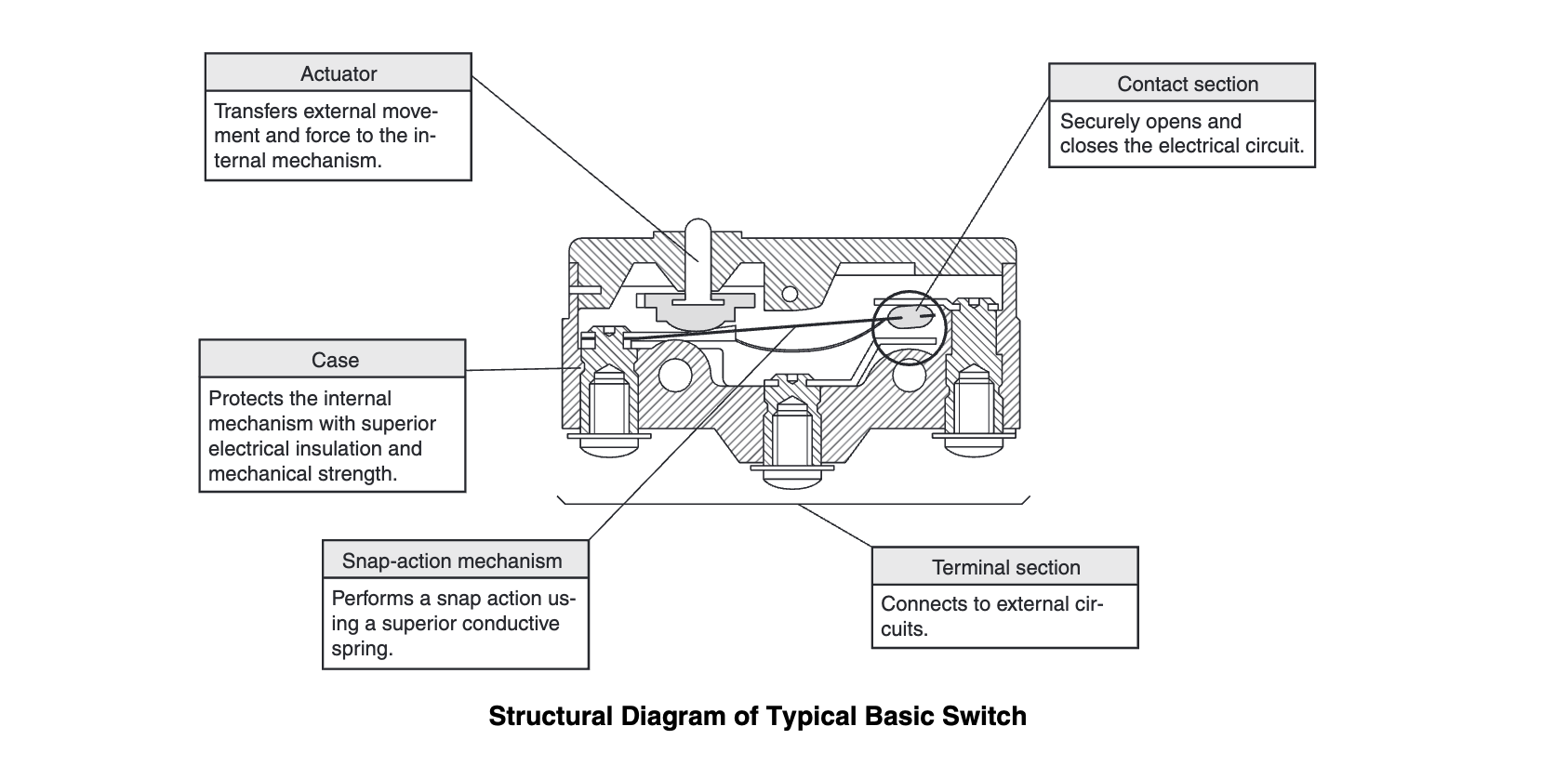
How Does a Micro Switch Work?
Micro switches operate through a precision mechanism that enables rapid and reliable switching regardless of the speed of actuation. This unique functionality relies on a carefully engineered spring-loaded system that creates the distinctive “snap” action.
The operation of a micro switch can be broken down into four distinct phases
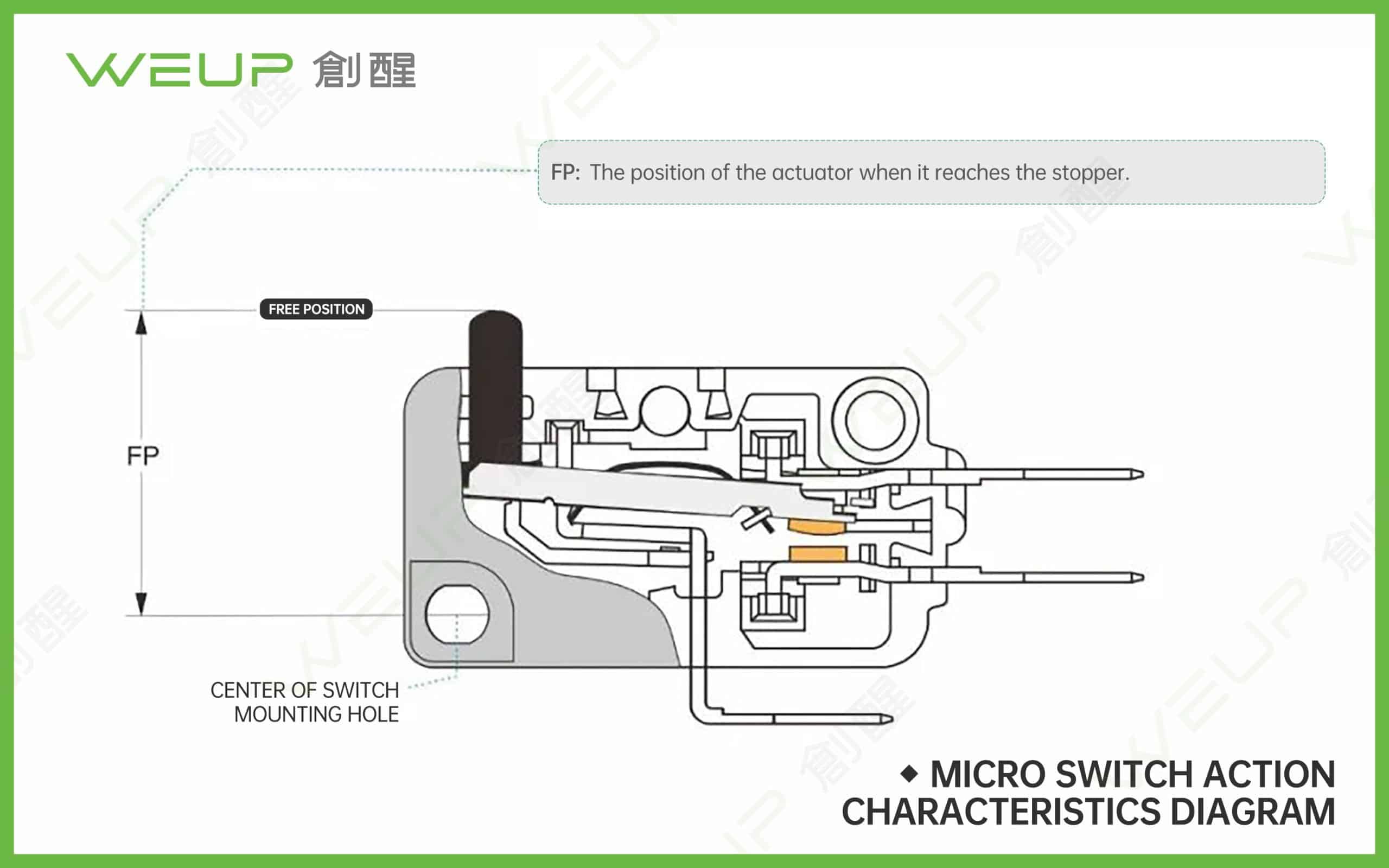
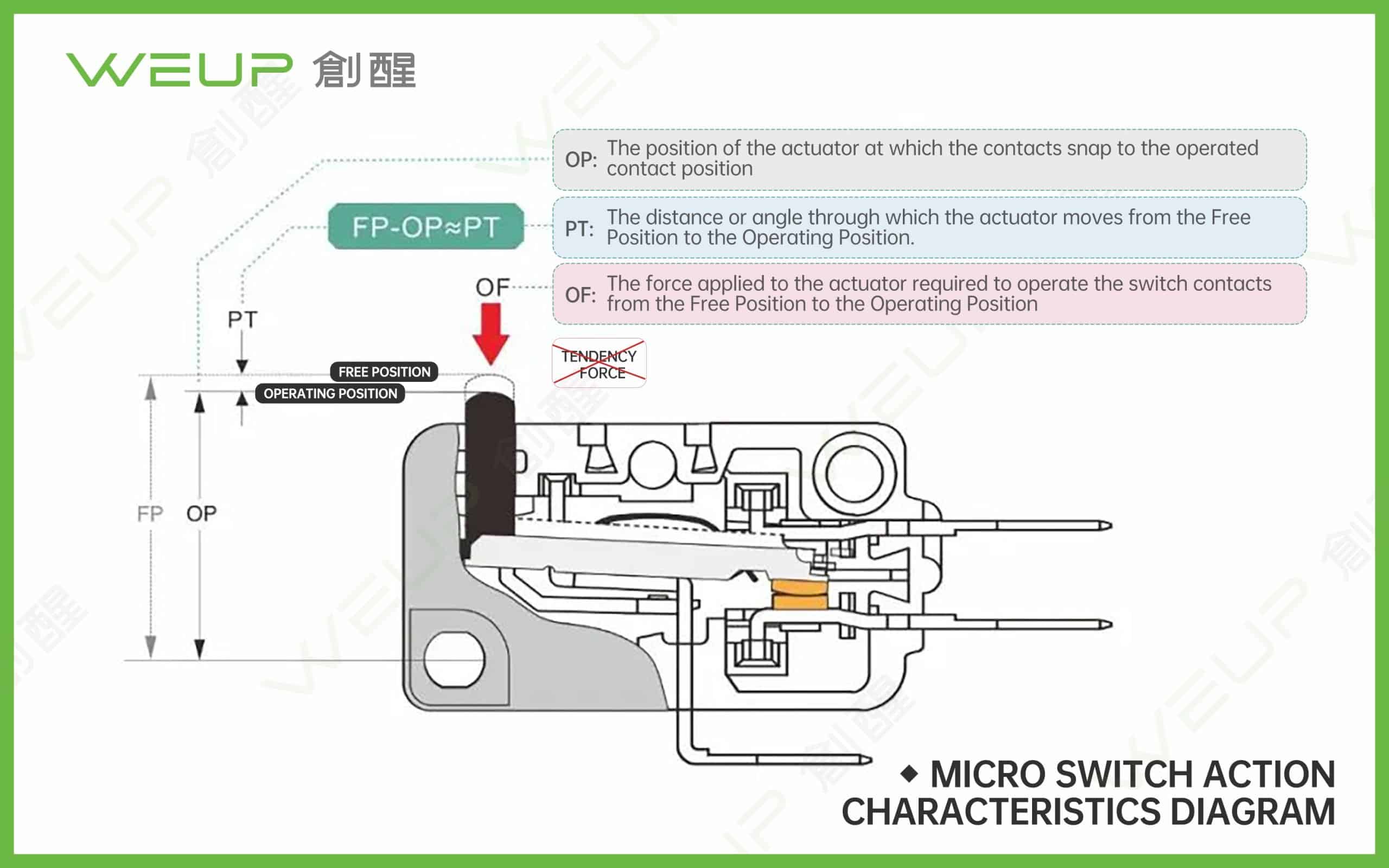
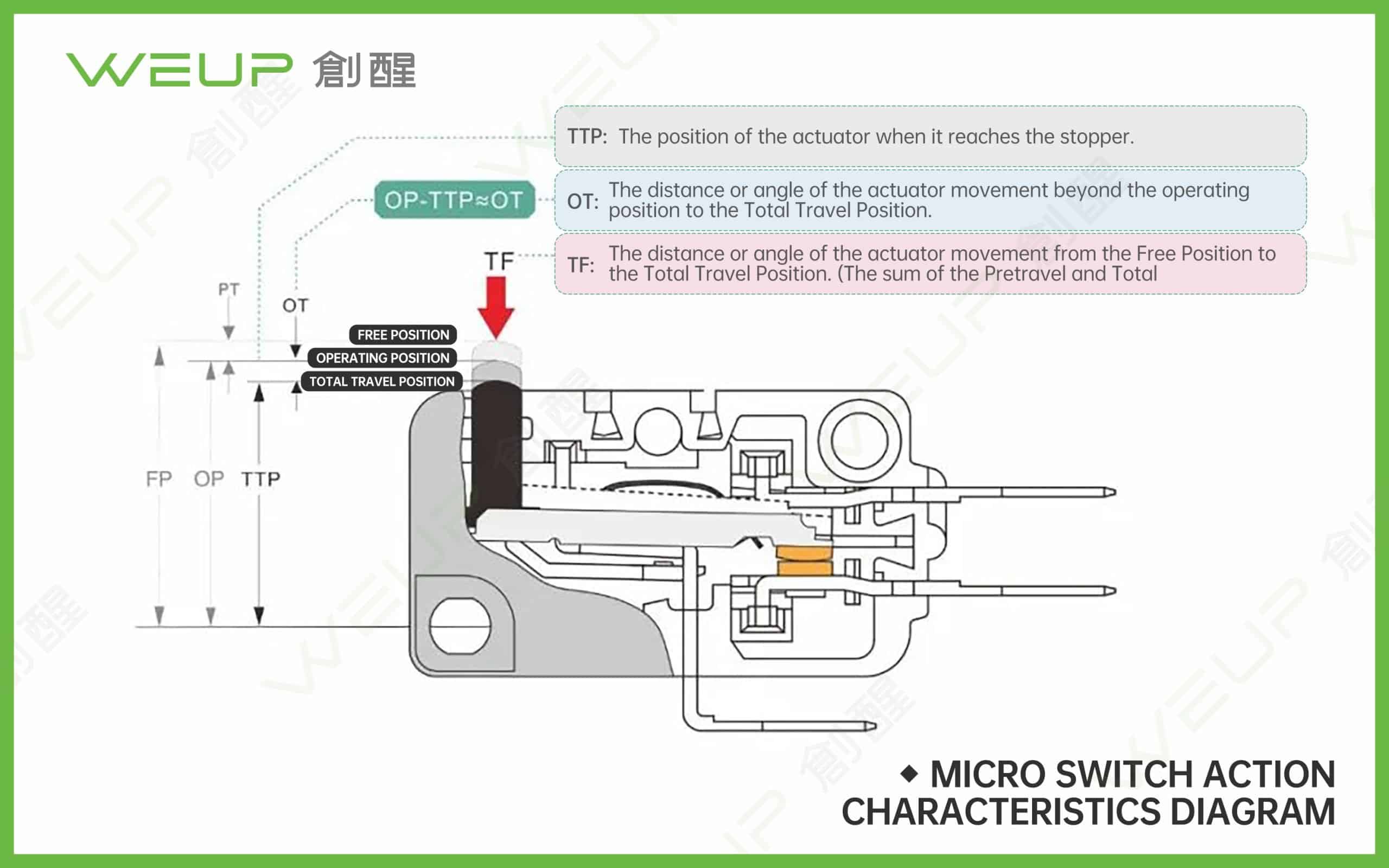
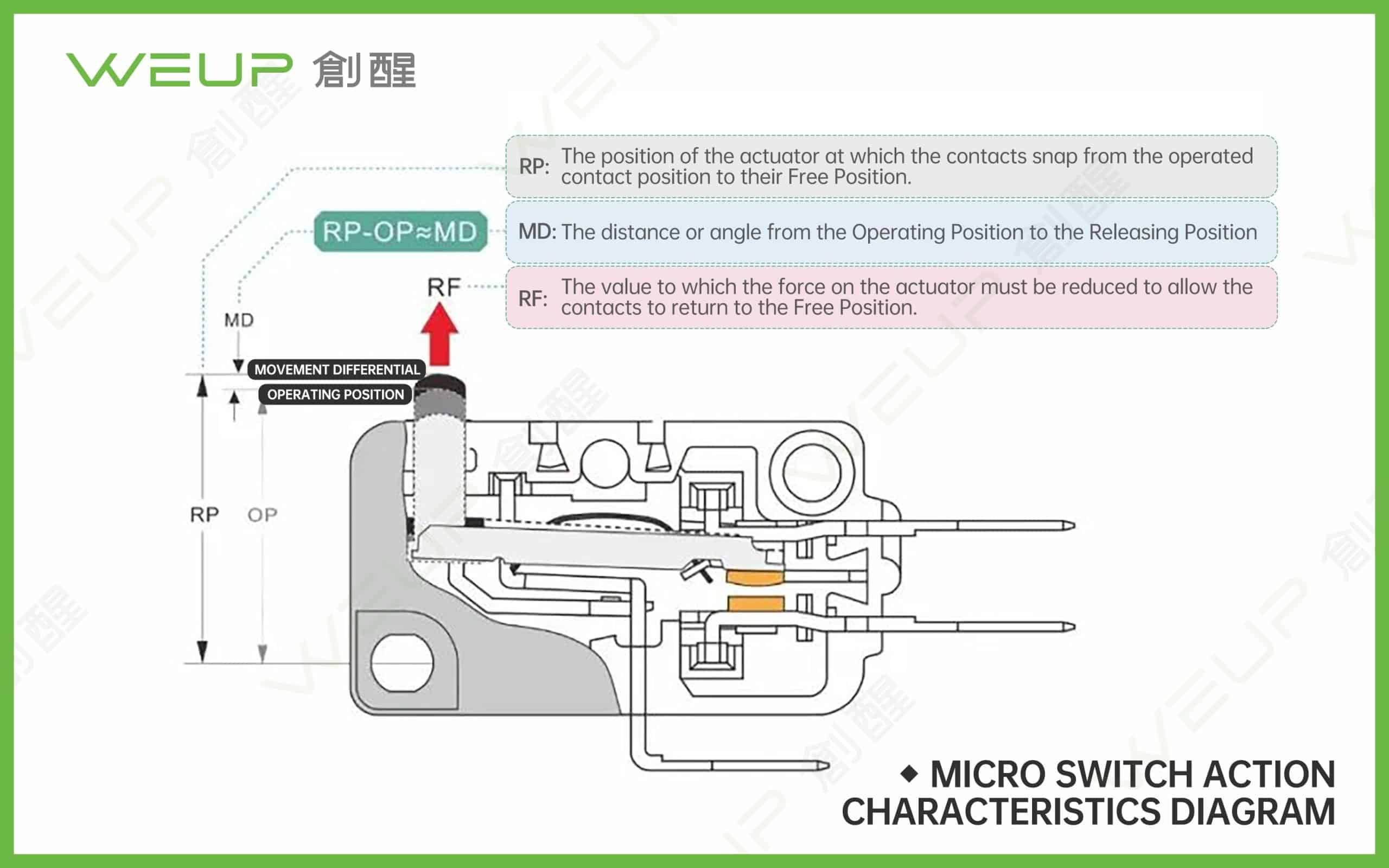
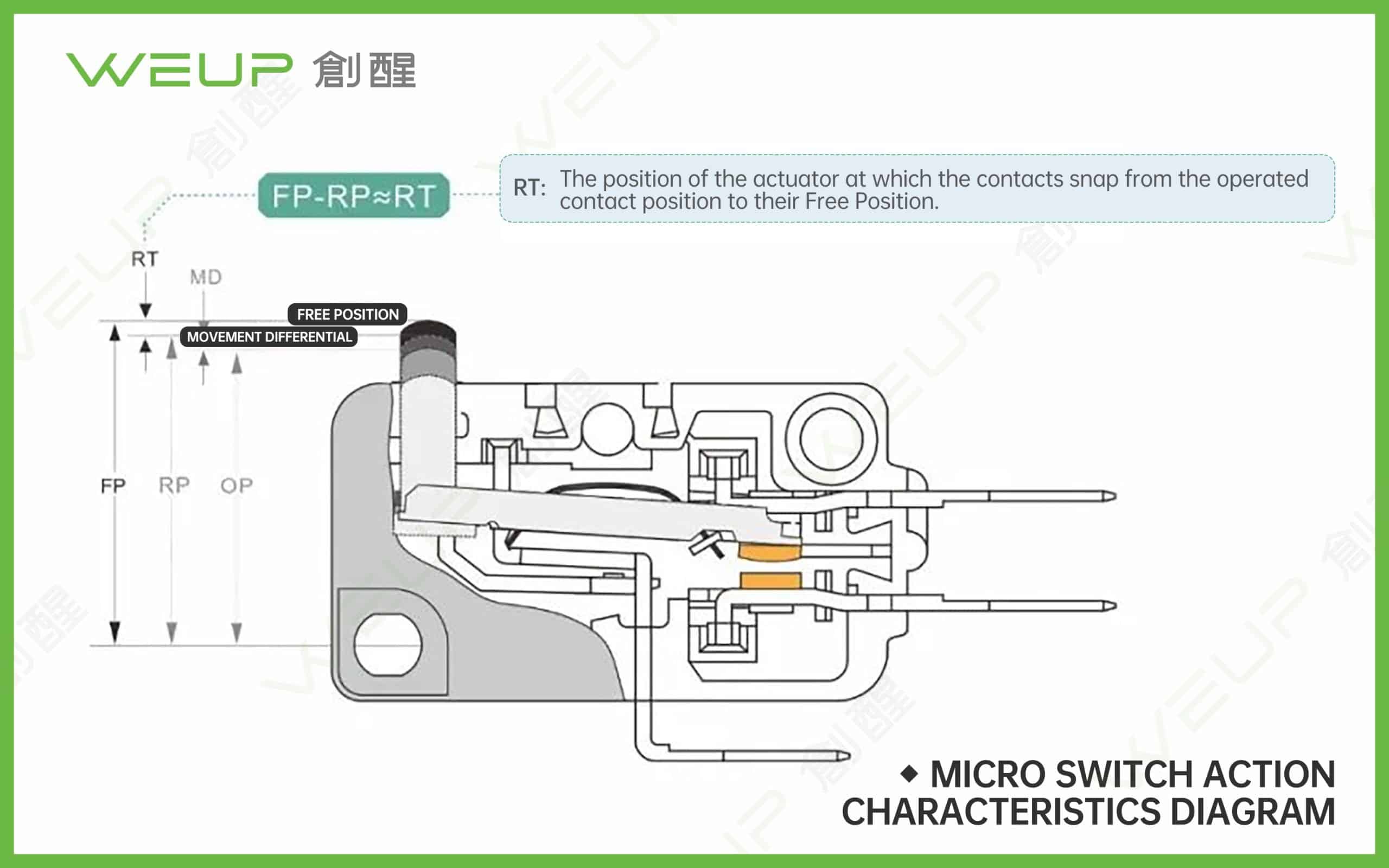
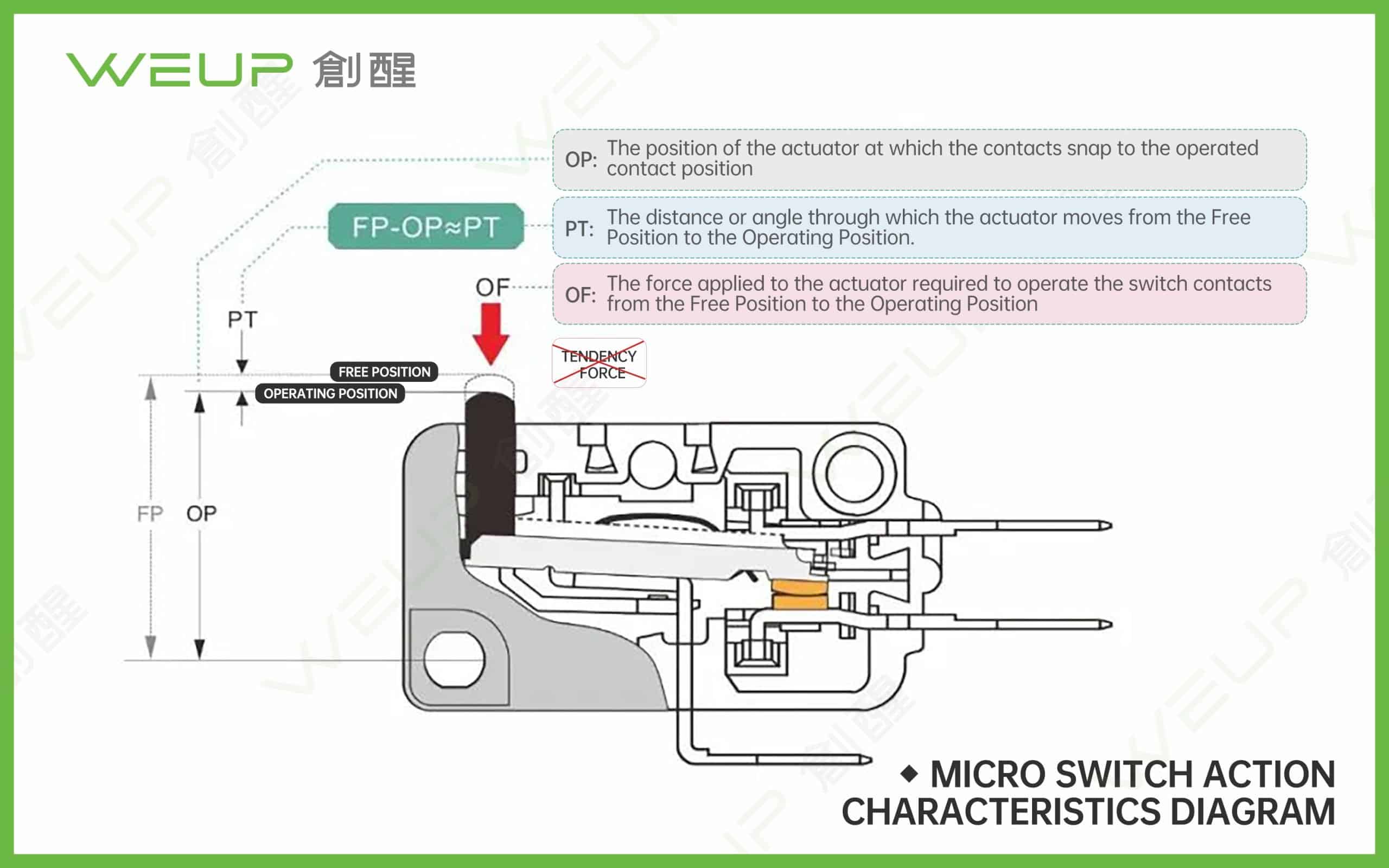
- Rest Position: In its default state, the internal electrical contact is either closed (NC) or open (NO), depending on the switch configuration. No current flows in the case of a normally open contact.
- Actuation: When the actuator (lever, push-button, or another mechanism) is subjected to sufficient external force to exceed the operating force (OF), the internal mechanism triggers abruptly. This rapid movement is due to the design of the snap-action system, which transitions instantaneously from one stable position to another.
- Switching: The snap-action mechanism alters the state of the internal electrical contacts. If the switch is normally open (NO), the contact closes, and current flows. If the switch is normally closed (NC), the contact opens, interrupting the current. For toggle switches (SPDT or DPDT), the current switches from one circuit to another.
- Return to Initial Position: Once the applied force is removed or reduced below a certain threshold (known as the release force, RF), the internal mechanism returns to its initial position, restoring the circuit’s default state.
This precise mechanical operation makes micro switches exceptionally reliable, with consistent performance over millions of cycles. The snap-action mechanism also provides excellent resistance to vibration and shock, further enhancing reliability in demanding environments.
By Special Features

Designed with complete sealing against environmental factors, these switches offer excellent protection in harsh conditions. While they typically have lower current ratings, their environmental protection makes them invaluable in challenging environments.
- Applications: Corrosive environments, outdoor equipment, marine applications
- Advantages: Excellent environmental protection, resistance to moisture and contaminants
- Considerations: Lower current ratings, typically more expensive
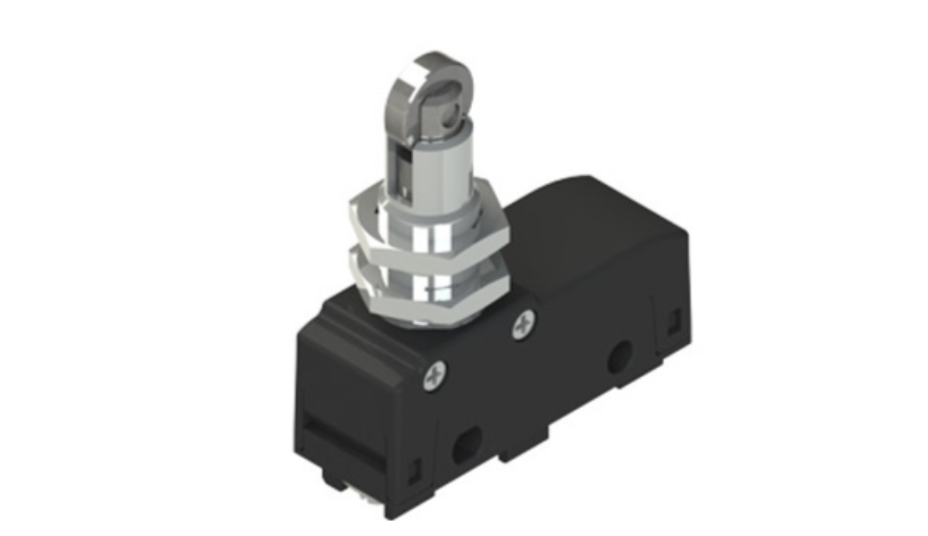
Engineered for higher current and voltage ratings, these robust switches are suitable for industrial applications and situations requiring frequent operation under load.
- Applications: Industrial equipment, power control, high-current circuits
- Advantages: Higher electrical ratings, robust construction, long service life under load
- Considerations: Larger size, may require more actuation force
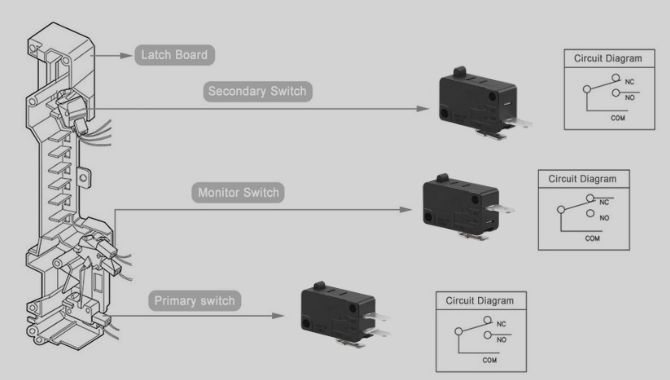
Specially designed with materials that can withstand extreme temperatures, these switches are essential in applications like ovens, furnaces, and industrial heating equipment.
- Applications: Ovens, furnaces, industrial heating, automotive engine compartments
- Advantages: Withstands extreme temperatures, maintains reliability in harsh conditions
- Considerations: Specialized design may limit other features
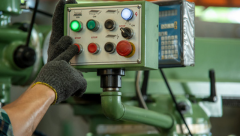
These specialized switches remain in their triggered state until manually reset, providing an important safety feature in applications where automatic restart could be hazardous.
- Applications: Safety systems, furnaces, equipment requiring manual restart after fault
- Advantages: Prevents automatic restart after fault conditions, enhances safety
- Considerations: Requires manual intervention to reset
Micro Switch vs. Limit Switch: Understanding the Differences
- Key Differences
- When to Use Each
- Using Micro Loads
| Characteristic | Micro Switch | Limit Switch |
|---|---|---|
| Size and Sensitivity | Smaller and more sensitive | Larger and typically more robust |
| Function | Component that can be integrated into various devices | Complete device often containing a micro switch inside |
| Construction | Basic switching element | Often includes a micro switch with additional housing and actuator |
| Contact Gap | Smaller contact gap | Larger contact gap |
| Primary Applications | Versatile component used in many devices | Primarily used for position detection in machinery |
| Environmental Protection | Varies, may require additional protection | Often includes robust housing for industrial environments |
| Mounting | Requires integration into a system | Usually includes mounting provisions |
Choose a Micro Switch When:
- You need a compact component for integration into a larger system
- High precision and sensitivity are required
- You’re designing a custom device that needs a standardized switching element
- Space constraints are significant
- You need flexibility in how the switch is actuated and mounted
Choose a Limit Switch When:
- You need a complete position detection solution
- The application requires robust environmental protection
- You need pre-configured mounting options
- The switch will be exposed to harsh industrial conditions
- You prefer a ready-to-use solution rather than integrating components
In many cases, limit switches contain micro switches as their internal switching element, with additional housing, actuators, and protection to make them suitable for industrial environments. Understanding this relationship helps clarify when each type is most appropriate for your application.
Using a model for ordinary loads to open or close the contact of a micro load circuit may result in faulty contact. Use models that operate in the following range.
However, even when using micro load models within the following operating range, if inrush current occurs when the contact is opened or closed, it may increase the contact wear and so decrease durability. Therefore, insert a contact protection circuit where necessary.
The N-level reference value applies for the minimum applicable load. This value indicates the malfunction reference level for the reliability level of 60% (λ60).
(JIS C5003)
The equation, λ60=0.5×10-6/operation indicates that the estimated malfunction rate is less than operations with a reliability level of 60%.
Micro switches offer numerous benefits that make them indispensable in modern electronics and mechanical systems. Their ingenious design and reliable performance have established them as essential components across various industries.
Snap-action Mechanism
The defining feature of micro switches is their snap-action mechanism, which ensures instantaneous switching regardless of actuation speed. This characteristic allows for precise control, even in demanding or high-frequency environments, and minimizes contact bounce for clean, reliable switching.
High Durability
Micro switches are designed to withstand millions of mechanical and electrical cycles without losing precision. This exceptional longevity makes them an economical and reliable choice for applications requiring frequent operation over extended periods.
Compact Size
Despite their robust performance, micro switches maintain a compact form factor that enables integration into tight spaces while delivering high electrical capacity. They are available in a wide range of sizes, actuation forces, and switching types to accommodate diverse application requirements.
Versatile Load Handling
From delicate electronic signals (a few milliamps) to high-intensity industrial applications (several amps), micro switches can handle a broad spectrum of electrical loads. This versatility makes them suitable for everything from sensitive control circuits to power-switching applications.
Minimal Electrical Loss
Due to their low contact resistance, micro switches generate virtually no electrical loss in circuits. This efficiency is particularly valuable in battery-powered devices and energy-sensitive applications where power conservation is critical.
Precise Actuation Point
The mechanical design of micro switches ensures they activate at a specific, repeatable position. This precision is crucial for applications requiring exact timing or positioning, such as limit switches and safety interlocks.
Easy Installation
Equipped with various connection options (terminals, wires, connectors) and mounting systems tailored to user needs, micro switches are easy to install and integrate into different systems. This flexibility simplifies design and maintenance processes.
Robust Construction
Available with sealed housings and durable materials, micro switches can withstand harsh conditions including extreme temperatures, humidity, dust, vibrations, and shocks. This robustness ensures reliable operation even in challenging environments.
Wide Operating Temperature Range
Many micro switches are designed to function reliably across a broad temperature spectrum, from sub-zero environments to high-heat applications. This thermal versatility expands their utility across diverse operating conditions.
Cost-effective Solution
The combination of long service life, reliable performance, and relatively low unit cost makes micro switches an economical choice for many applications. Their durability reduces replacement frequency, further enhancing their cost-effectiveness.
Standardized Designs
Many micro switches follow industry-standard dimensions and specifications, facilitating easy replacement and interchangeability. This standardization simplifies maintenance and reduces downtime when replacements are needed.
Related Products
FAQs
Micro switches are commonly used in various applications, and people often have questions about them. Here are five of the most popular FAQs for Micro switches?
A micro switch is an electromechanical device with snap-action or slow-action functionality, designed to open or close an electrical circuit in response to physical pressure or position changes. These compact switches are characterized by their ability to operate with minimal force while providing precise, reliable switching action.
Micro switches come in various types including Single-Pole Single-Throw (SPST), Single-Pole Double-Throw (SPDT), Double-Pole Double-Throw (DPDT), and different actuator types such as pin plunger, spring pin plunger, hinge roller lever, rotating operation, leaf spring, and panel mount plunger micro switches.
Selecting the right micro switch involves considering electrical requirements (current/voltage ratings, AC/DC operation), mechanical considerations (operating force, actuator type), environmental factors (temperature, humidity, dust), and contact material selection. Match these specifications to your application’s specific needs for optimal performance and reliability.
Micro switches are smaller, more sensitive components that can be integrated into various devices, while limit switches are complete devices often containing a micro switch inside with additional housing and actuator. Limit switches are primarily used for position detection in machinery and typically offer more robust environmental protection.
High-quality micro switches are designed to last for millions of mechanical and electrical cycles. The exact lifespan depends on factors such as operating conditions, switching frequency, electrical load, and environmental factors. Under normal conditions, micro switches can operate reliably for 1-10 million cycles or more.
Standard micro switches are not suitable for wet environments without additional protection. However, hermetically sealed or waterproof micro switches are specifically designed for use in humid or wet conditions. These switches feature sealed housings that prevent moisture ingress, making them suitable for outdoor applications, marine environments, and washdown areas.
The operating force (OF) of micro switches varies widely depending on the design and intended application. Typical values range from as low as 0.5 ounces (14 grams) for sensitive applications to several pounds (kilograms) for switches designed to prevent accidental activation. The exact specifications are always provided in the manufacturer’s datasheet.




